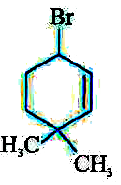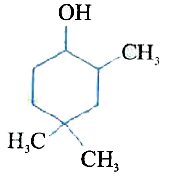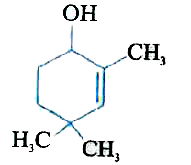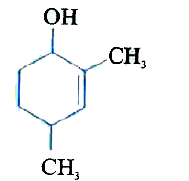2-Phenyl-2-chloropropane on treatment with alc. KOH gives mainly
2-Phenylpropene
3-Phenylpropene
1-Phenylpropan-2-ol
1-Phenylpropan-3-ol
The correct Answer is:A
To solve the question regarding the reaction of 2-Phenyl-2-chloropropane with alcoholic KOH, we can follow these steps:
Step 1: Understand the Reactants
2-Phenyl-2-chloropropane has the following structure:
- It consists of a propane chain (3 carbon atoms) with a phenyl group (C6H5) attached to the second carbon and a chlorine (Cl) atom also attached to the second carbon.
- The structure can be represented as:
Cl|C6H5−C−CH3|CH2
Step 2: Identify the Role of Alcoholic KOH
Alcoholic KOH serves as a strong base. In this reaction:
- The hydroxide ion (OH-) can act as a base and will abstract a proton (H+) from a β-hydrogen (hydrogen atom on the carbon adjacent to the carbon bearing the leaving group, Cl).
- The reaction will lead to the elimination of HCl.
Step 3: Determine the β-Hydrogens
In 2-Phenyl-2-chloropropane, the β-hydrogens are on the carbon atoms adjacent to the carbon with the Cl group. Here, both β-hydrogens are equivalent due to the symmetrical nature of the molecule.
Step 4: Elimination Reaction
When alcoholic KOH abstracts a β-hydrogen, HCl is eliminated:
- The elimination of HCl leads to the formation of a double bond between the two adjacent carbon atoms.
- The reaction can be represented as follows:
ClH∣|C6H5−C−CH3+KOH→C6H5−C=CH2+HCl+KCl+H2O|CH2
Step 5: Final Product
The major product of this elimination reaction is:
- 1-Phenylpropene, which has the structure:
C6H5∣CH=CH−CH3
Conclusion
Thus, the main product formed when 2-Phenyl-2-chloropropane is treated with alcoholic KOH is 1-Phenylpropene.
---
2-Phenyl-2-chloropropane has the following structure:
- It consists of a propane chain (3 carbon atoms) with a phenyl group (C6H5) attached to the second carbon and a chlorine (Cl) atom also attached to the second carbon.
- The structure can be represented as:
Cl|C6H5−C−CH3|CH2
Alcoholic KOH serves as a strong base. In this reaction:
- The hydroxide ion (OH-) can act as a base and will abstract a proton (H+) from a β-hydrogen (hydrogen atom on the carbon adjacent to the carbon bearing the leaving group, Cl).
- The reaction will lead to the elimination of HCl.
In 2-Phenyl-2-chloropropane, the β-hydrogens are on the carbon atoms adjacent to the carbon with the Cl group. Here, both β-hydrogens are equivalent due to the symmetrical nature of the molecule.
When alcoholic KOH abstracts a β-hydrogen, HCl is eliminated:
- The elimination of HCl leads to the formation of a double bond between the two adjacent carbon atoms.
- The reaction can be represented as follows:
The major product of this elimination reaction is:
- 1-Phenylpropene, which has the structure:
Thus, the main product formed when 2-Phenyl-2-chloropropane is treated with alcoholic KOH is 1-Phenylpropene.
Topper's Solved these Questions
- BOOK - MODERN PUBLICATIONCHAPTER - HALOALKANES AND HALOARENESEXERCISE - B. MULTIPLE CHOICE QUESTIONS (from competitive Examinations)63videos
HALOALKANES AND HALOARENES
- BOOK - MODERN PUBLICATIONCHAPTER - HALOALKANES AND HALOARENESEXERCISE - C. MULTIPLE CHOICE QUESTIONS (with more than one correct answers)10videos
HALOALKANES AND HALOARENES
- BOOK - MODERN PUBLICATIONCHAPTER - HALOALKANES AND HALOARENESEXERCISE - HIGHER ORDER THINKING SKILLS13videos
HALOALKANES AND HALOARENES
- BOOK - MODERN PUBLICATIONCHAPTER - EQUILIBRIUMEXERCISE - Unit Practice Test13videos
EQUILIBRIUM
- BOOK - MODERN PUBLICATIONCHAPTER - HYDROCARBONSEXERCISE - UNIT PRACTICE TEST15videos
HYDROCARBONS
Similar Questions
Knowledge Check
- Question 1 - Select One
1-phenyl-2-chloropropane on treating with alc. KOH gives mainly
A1-phenylpropeneB2-phenylpropeneC1-phenylpropane-2-olD1-phenylpropane-1-ol - Question 2 - Select One
 on treatment with aqueous KOHA
on treatment with aqueous KOHA B
B C
C D
D
- Question 3 - Select One
A mixture of 1−chloropropane and 2−chloropropane when treated with alcoholic KOH, it gives
A1-propeneB2-propeneCIsopropyleneDAll of the above
2-Chloro-2-methylpropane on reaction with aqueous KOH gives X as the major product. X is
View SolutionEthyl bromide on treatment with alcoholic KOH gives
View SolutionEthylene dichloride on treatment with aqueous KOH gives
View SolutionA mixture of 1−chloropropane and 2−chloropropane when treated with alcoholic KOH, it gives
View SolutionA mixture of 1− chloropropane and 2− chloropropane which treated with alcoholic KOH gives
View Solution

